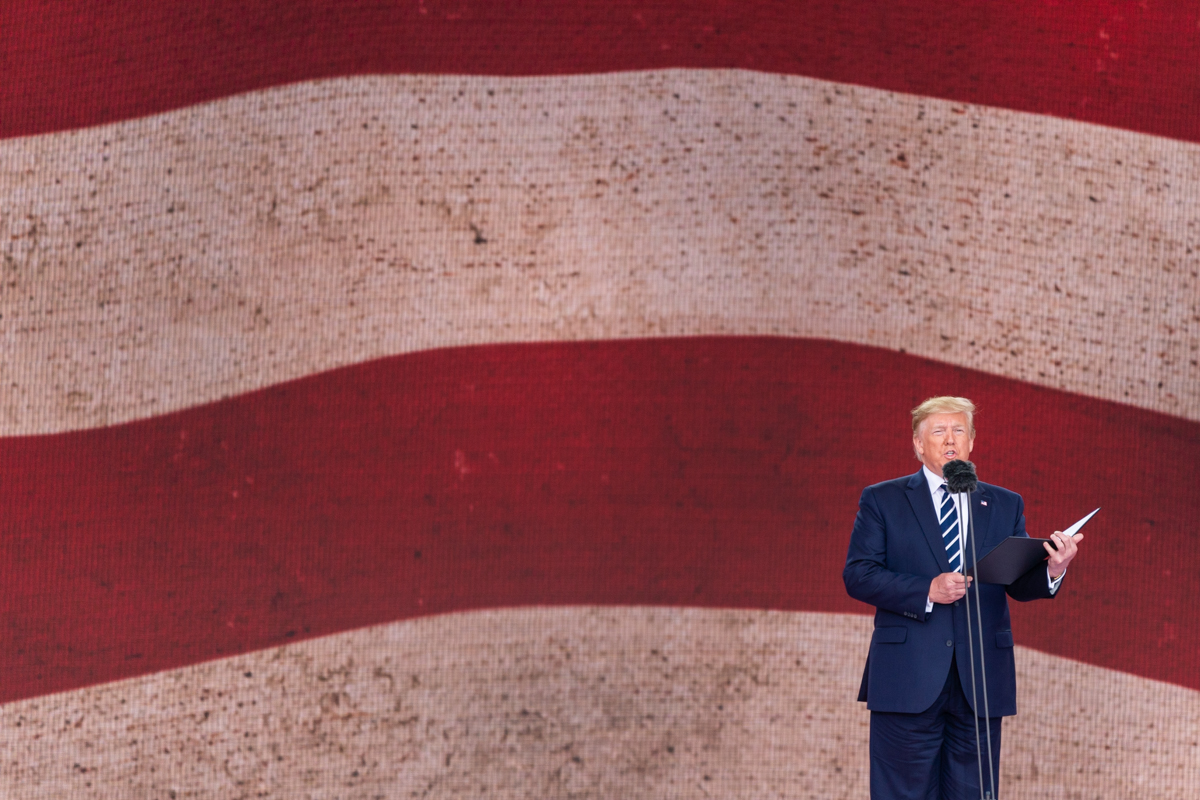How History Repeats Itself: Gloss and the Foreign Relations Constitution
A review of Curtis Bradley, “Historical Gloss and Foreign Affairs: Constitutional Authority in Practice” (Harvard University Press, 2024)

Published by The Lawfare Institute
in Cooperation With

Curtis Bradley may be the most accomplished scholar in the field of foreign relations law—with leading works on numerous issues, including the judicial incorporation of customary international law, the “Charming Betsy” canon concerning the interpretation of domestic law in view of international law, congressional-executive and sole executive agreements, treaty withdrawal, and many other subjects, not to mention a superb monograph on international law in U.S. courts, an excellent co-authored casebook, and his field-spanning work as a reporter on the “Restatement of the Law (Fourth): The Foreign Relations Law of the United States.” This is putting aside comparative foreign relations law, a field that he either helped create or (looking back a good ways) reinvigorated.
Bradley has also written on broader topics in constitutional law and constitutional theory that have keen relevance to foreign affairs. One example of the former is a terrific reexamination of the effects of declaring legislative vetoes unconstitutional. An example of the latter is his work with Trevor Morrison (and, later, with Neil Siegel) on historical gloss and the Constitution.
Bradley’s new book, “Historical Gloss and Foreign Affairs: Constitutional Authority in Practice,” synthesizes these pursuits. It applies his more general work on the influence of presidential and congressional practice on constitutional interpretation to the foreign relations field in a sustained, masterful way, with many illustrations of interest to scholars, judges, and practitioners working in the field. It is thoroughly excellent, and excellently thorough. It also raises important issues about the means by which executive and legislative activity—including, particularly in the latter case, its absence—shape the Constitution.
At the book’s core is the notion of “gloss,” in which a pattern of government practice is conceived of as giving meaning to some of the Constitution’s “broad phrases.” As Bradley notes, the term’s modern use in constitutional cases may be owed to Justice Felix Frankfurter, who in his concurrence in the 1952 steel seizure case, Youngstown Sheet & Tube Co. v. Sawyer, explained that:
a systematic, unbroken, executive practice, long pursued to the knowledge of the Congress and never before questioned, engaged in by Presidents who have also sworn to uphold the Constitution, making as it were such exercise of power part of the structure of our government, may be treated as a gloss on “executive Power” vested in the President by § 1 of Art. II.
A much more recent example of the Supreme Court’s embrace of this approach, though not itself arising from foreign affairs, appeared in NLRB v. Noel Canning, a case concerning President Obama’s use of recess appointments to stock the National Labor Relations Board during a break in the middle of a legislative session. In concluding that such a break did not qualify as a “recess” for constitutional purposes, the Court placed “significant weight upon historical practice”—having first satisfied itself that the constitutional text was unclear—and stressed the appropriateness of considering the conduct of Congress and the president as to matters concerning the constitutional division of their authority. Justice Antonin Scalia, writing separately, disagreed chiefly about whether the constitutional text was sufficiently ambiguous to permit the majority’s interpretative move.
Bradley goes beyond Noel Canning and other cases in articulating several possible reasons for giving weight to historical gloss, dividing them neatly into “Burkean” justifications (resting on practice’s presumed practicality and the value of leaving well enough alone), “comparative institutional competence,” and “constitutional effectiveness and legitimacy[.]” Bradley (like the Court in Noel Canning) finds the arguments for deferring to historical practice most persuasive in the separation of powers context, and he describes a respect for gloss as consistent (though not without exception) with Supreme Court and political branch practice. He explains his viewpoint in terms of more abstract principles, economically and with greater rigor than has the Supreme Court, but the book chiefly illustrates the value of context, via illustrations. Historical gloss as presented in “Historical Gloss and Foreign Affairs” is predominantly a descriptive theory, rooted in how national political actors, with occasional approval by the judiciary, understand their conduct to shape constitutional meaning. After showing how the Constitution’s text leaves much open for debate, Bradley devotes successive chapters to how political actors, and sometimes courts, have used gloss in connection with the recognition power, making Article II treaties and other international agreements, terminating those agreements, use of military force, and certain exercises of congressional authority.
In these case studies, Bradley does a great job not only of surveying formative historical episodes—for which he canvasses primary and secondary materials, focusing on legal positions expressed by executive branch officials and Congress regarding their constitutional authority—but also in noting the challenge of drawing unambiguous conclusions from those episodes or materials, repeatedly cautioning against overreading the evidence. His caution derives in part from his acute awareness of an important concern about using gloss: that executive branch officials are institutionally better situated to synthesize and express their views, in the moment and for posterity, as to how practice supports their authority. This means, significantly, that relying on historical gloss tends to augment presidential authority.
For example, in assessing the legality of Obama administration air strikes against Libya, and later Trump administration strikes against Syria, the Justice Department’s Office of Legal Counsel (OLC) used the language of gloss in asserting that military engagements of limited scope and duration fall within the president’s commander-in-chief power rather than Congress’s authority to declare war. Bradley notes that while these opinions show the vitality of gloss, neither was particularly compelling on its merits. By contrast, regarding federal statutes regulating the conduct of diplomacy, OLC downplayed congressional incursions that had drawn little overt executive-branch protest, invoking instead the executive’s internal legal views and its occasional practice. As Bradley observes, congressional acquiescence on either issue is far from clear, and the better view is probably that matters remain in equipoise. His evaluation of such issues is consistently fair-minded and illuminating, and it’s important to distinguish between one’s satisfaction with this state of affairs and Bradley’s account of it. The book provides a rich set of examples for anyone interested in how the executive branch and Congress iron out their constitutional roles in foreign affairs, usually without active supervision by the judiciary.
Naturally, a work tackling such a difficult subject, and with such a broad compass, cannot address all the issues or resolve all the uncertainties, which happily leaves me with something to write besides heaps of well-deserved praise. One set of questions concerns the criteria for what counts as “gloss.” Bradley limits it to governmental practice that is “longstanding” and demonstrates sufficient acquiescence. The requirement that the practice be longstanding—which perhaps does not require that the practice be current, if it was at some point observed for long enough—is hard to define in any way that shows reliably when it is satisfied. The acquiescence factor, Bradley observes, may be “[t]he most debated[.]” Bradley disagrees with others, such as Shalev Roisman, who might ask “that the affected branch must have actually agreed that the practice is constitutional” (emphasis in original), because Bradley considers that neither gloss’s principled justifications nor judicial opinions require agreement before deference is warranted. Instead, in his view, acquiescence simply requires reasonable stability over time (thus melding with duration) “without generating continued interbranch contestation[.]”
Skipping any agreement requirement avoids difficult questions—for example, as Bradley notes, whether an affected branch’s silence may be deemed to indicate agreement in another’s practice—but it might quite substantially expand gloss’s potential application. It is also unclear how contestation should then be treated. Bradley must be right that consistent objection would undermine the value of the objected-to practice as an indicator of constitutional meaning. At the other end of the spectrum, though, an affected branch might have been unaware of what was at stake, suffered in silence due to a lack of political capacity, or been biding its time while awaiting a higher-stakes moment at which to make its stand—with the result in each case that the arguments for or against a given practice remained untested before the public and the courts. Arguably openly contested practice, followed eventually by victory by one branch and acquiescence by another, is the best guide: The Constitution having established what constitutional scholar Edward Corwin called “an invitation to struggle” between the branches, clear struggles, and clear victories, indicate the best-vetted and most authoritative gloss, at least in the absence of clear agreement. On this view, congressional regulation of diplomacy may better establish a gloss of its constitutional authority by virtue of the executive’s periodic but unsustained resistance to it, even more so than if its interventions had gone unchallenged.
Bradley’s preference for minimally contested practices is defensible as well, and this gets at a larger problem. Where do the criteria come from, and why do we prefer one account to another? The primary source for the criteria seems to be practice itself. Thus, Bradley resists Justice Frankfurter’s allusion to a “systematic, unbroken, executive practice, long pursued to the knowledge of Congress and never before questioned”: not because it is too demanding in principle, but because other judicial decisions, and political actors, do not seem to require that much acquiescence—and they are more permissive “presumably” because that would leave too few practices to qualify. This is consistent with the book’s largely descriptive nature, but it cannot be the whole story. It is hard to guess at the quality or quantity of practice among the branches that established these criteria, unless the theory is somehow recursive, so as to itself rely on institutional practices. There are also exceptions. Bradley resists the suggestion that actual agreement by the affected branch is required, for example, largely because it fits poorly with persuasive justifications for crediting gloss. Those justifications are better attributed to academic reflection than to compiled musings by the branches about when what they do matters. Even when relevant actors directly invoke gloss, they rarely speak to the criteria; that makes it far easier for members of Congress (or executive branch officials) to deny the significance of their apparent acquiescence on any particular occasion, and places a greater burden on scholarship to make a normative case for its value as a source of constitutional meaning.
A second set of questions concerns the consequences of gloss. For all intents and purposes, gloss seems to be serving as constitutional precedent: when enough practice of the right type has accrued, a branch is deemed to be justified in claiming, based on past (successful) assertions, that it has constitutional authority of the kind it claims. To be sure, Bradley notes that “gloss is not necessarily permanent” and that it can be “re-glossed[.]” His illustration of such re-glossing, involving practice that changes mid-course before it is ever fixed, is an easy case that offers limited guidance. Quite defensibly, Bradley brackets and postpones the difficult task of comprehensively explaining when re-glossing may be said to occur, but the challenges that task will present give pause. One suspects it will prove somewhat harder than identifying when courts have done their own kind of re-glossing by overturning precedent or otherwise slipping the constraints of constitutional stare decisis, given the greater variety among political precedents and the usual absence of a final judicial arbiter.
It’s worth noting that glossing and re-glossing might be handled in a different—less decisive—way. Assuming ambiguous constitutional text and well-established practice, courts entertaining a challenge might let that practice stand without otherwise fixing the expectations of the asserting or affected branches (or third parties). Whether this more abstention-like approach to gloss is a superior descriptive account might itself depend on practice, as measured by Bradley’s examples and, perhaps, others. But it is consistent with Justice Robert Jackson’s famous concurrence in Youngstown Sheet & Tube Co. v. Sawyer (1952), cited as a formative example of gloss, if his famous three tiers are understood to prescribe the occasions for judicial intervention—rather than as guides to how the Constitution should be authoritatively reckoned. Jackson’s assessment of the circumstances bearing on presidential power, that is, had less to do with longstanding practice than with how the president and Congress are acting in the moment; his basic insight was, after all, that the president’s powers “are not fixed but fluctuate” depending on what Congress is doing at the time. Bradley is definitely sympathetic to concerns that “a judicial decision crediting practice has the potential to freeze the practice in place, thereby undermining gloss’s ability to evolve in response to new circumstances” and, therefore, to greater indulgence of judicial abstention doctrines like the political question doctrine. Even so, his understanding of gloss, in which it would settle (if not necessarily irrevocably) constitutional meaning rather than describe when courts should intervene, will tend to interfere with that evolutionary potential.
These first two sets of issues—concerning the criteria for, and consequences of, gloss—relate closely to a third problem that, as previously noted, Bradley confronts head on: gloss may systematically favor presidential power because the president can act (and react) more easily than Congress can. The book mitigates this concern somewhat by recounting, in Chapter 7, how Congress has also used gloss (for example, in connection with regulating passports) and by discussing, in Chapter 8, the mixed case of congressional delegations of authority to the executive branch. Bradley (like Justice Scalia in Noel Canning) generally concedes the president’s advantage but explains that it is difficult to know what to do about it (unlike Scalia, who was inclined, at least in that case, to accord greater weight to arguably ambiguous constitutional text and less to practice by the political branches). As modest correctives, he suggests, among other things, scrutinizing executive branch claims of authority carefully to remedy overclaiming, taking readier note of failures by the executive branch to use this relative capacity to protect its prerogatives, and considering soft forms of congressional opposition, such as committee reports, as legitimate parts of its arsenal. All this seems reasonable, but arguably correctives like these should only be considered part of the gloss orthodoxy if the relevant institutional actors (and not just Congress) regularly credit them; otherwise, the theory tips again from a primarily descriptive account to one that answers normative objections with normative tweaks.
Bradley also observes that it is hard to determine a baseline by which one might “measure whether the executive branch is acquiring too much authority[.]” Certainly the proper scope of executive authority is hard to resolve, and always has been. It is also fair to suggest, as Bradley does, that those objecting to gloss’s potential for executive aggrandizement might be asked what approach is preferable, and to query whether, for example, a functionalist would do better in that regard. He is also dubious, quite justifiably, that strict originalism about executive power would suit modern needs. Granting all this, gloss’s skew toward the president is still a substantial concern. Whether one assumes an initial allocation of some kind or a more modern basis for assignment, a mechanism for redistribution that systematically favors one participant is likely to stray from whatever the ideal allocation might be. Constitutional theories that are all-in on dynamic updating might have additional qualms about gloss, to the extent it regards as presumptive favorites accommodations that the political branches may have developed one or two hundred years ago. The point is not that gloss is a bad theory, or one that it is necessarily untrue to practice, but simply that agnosticism about its biases is hard to maintain without strong indications that this favoritism is itself accepted by practice.
To reiterate, these quibbles are ones that any theory of gloss might confront, and Bradley’s book is exceptional in the degree to which it engages such questions. His discussion in Chapter 3 of the recognition power nicely illustrates the complexities of any gloss-based account, particularly as it may be employed by the Supreme Court. Recognition of foreign governments is not an authority addressed in the Constitution, although it may be inferred from parts of Article II, such as the power to send and receive ambassadors and the power to make treaties with the advice and consent of the Senate; even if it’s (very) far from certain to fall within the Vesting Clause, it has long been accepted that the president may act unilaterally. The key question, as Bradley explains, is whether the power is exclusive, and thus should be free from congressional interference, or instead concurrent with congressional power, such that Congress may regulate it. Bradley’s review of important episodes, such as the neutrality controversy during the Washington administration over the U.S. position in the war between France and Britain, the recognition of Haiti, and disagreement over recognition of new republics in South America, among others, shows that political actors had varied impulses on that question, with little judicial supervision.
When the Supreme Court was finally forced to confront the question of exclusivity, in Zivotofsky v. Kerry (2015), it concluded that the power was exclusive and that a statutory provision governing passports had interfered with the president’s recognition determination. The Court asserted that its conclusion rested on “strong support” in historical practice that Bradley suggests was actually far from conclusive. The takeaway for a general theory of gloss is not obvious, and to his credit, Bradley avoids any oversimplification, noting not only the conflicting readings of history but also the exceptional character of recognition as a potentially exclusive power, its relationship to other authority, room for doubt about judicial review as a panacea, and the relevance of international law, among other things.
Beyond this, though, the contributing historical episodes suggest the possibility that political actors were driven less by committed or even tentative beliefs about the Constitution than by provisional judgments as to political expediency. That is, members of Congress might have believed recognition was unresolved under the Constitution (not least, given the discrepant takes by Hamilton and Madison) and something that might be left to the president so long as his choices were reasonably acceptable to the legislature. There were some higher-order discussions—like the prolonged hand-wringing in both political branches over South American recognitions under the Monroe administration—but even there the result was as much political accommodation as constitutional referendum. In sum, there is less evidence than one might like that congressional (or other) actors understood themselves to be making concessions that established legal precedent, let alone that their acquiescence contributed to any overarching criteria that could be used to resolve other separation-of-powers conflicts.
In theory, a solution for instances in which the branches find themselves at loggerheads, or without clear historical instruction, is judicial review. Bradley notes that judicial review is less common in foreign relations matters and that greater deference is shown to the political branches and to the executive branch in particular; these circumstances (which are linked to the lack of textual guidance) make the field particularly ripe for historical gloss. He is right in all of this, and in resisting accounts that have suggested that foreign affairs is becoming a more conventionally judicial domain.
Still, one thirsts for a more systematic understanding of the judicial decisions that speak to historical gloss. Some cases, like Noel Canning, are straightforward but somewhat narrow endorsements: At least when the text is ambiguous, practice can vindicate an interpretation that a constitutional provision’s purposes “demands,” where executive branch practice is fairly consistent and legally couched and congressional pushback is limited and even tended to define authority in a way that supports the executive’s view. Other decisions are more equivocal. Use of historical gloss in cases such as Field v. Clark (1892) and United States v. Curtiss-Wright Export Corporation (1936) may be viewed differently given the fundamental agreement between the executive and legislative branches on the propriety of delegation. Zivotofsky was, in its own way, as much a unicorn as Noel Canning: Neither the president nor Congress could rely on a clear constitutional grant, both depended on historical gloss, and the Supreme Court—less able, given concerted congressional action, to duck the constitutional dispute, as it had in Goldwater v. Carter (1979)—decided, very exceptionally, that the president’s authority was exclusive. Of course, a full assessment might have to take on all the cases in which gloss was not used by courts, which would be even harder to accomplish. Bradley cites the conspicuous example of INS v. Chadha (1983), in which the Court’s holding regarding the legislative veto was belied by hundreds of statutes, but there are likely others.
A broader, more adventurous, challenge would be this: If historical gloss requires acquiescence by the affected branch, why is the judiciary, entrusted ordinarily with the obligation to say what the law is, not regarded within the model as a second affected branch—with the consequence that historical gloss suggesting only some accord between the political branches, without judicial imprimatur, should have a categorically inferior status? Bradley’s future work might do more here. He resists any undue emphasis on judicial decisions and notes that it is unfair to reflexively relegate the constitutional views of the other branches to the position of “mere politics[.]” He is also quite mindful of the instances in which courts do weigh in, whether they defer to the practice of the political branches or not. Still, one wonders whether the compass of institutions with a discernible stake in institutional settlements should not be viewed more widely, with the result that settlements that have not been accepted by the judiciary—when it is colorably affected—might be viewed as categorically distinct. Furthermore, if informal means of congressional pronouncement should be counted, as Bradley suggests, there is at least an argument for considering dicta and other lesser judicial pronouncements, including instances in which courts have declined review on the basis of non-justiciability or when the Supreme Court has been badly divided.
To be clear, these are questions provoked by Bradley’s thoughtful discussion, not failings, and space prevents giving due attention to his compelling assessments in areas such as making and exiting international agreements, where he contributes substantially to the existing literature with a nuanced account. His is a book about gloss, not a glossing over. “Historical Gloss and Foreign Affairs” accomplishes the difficult task of introducing a field to newcomers and providing a fresh account for those unwisely thinking themselves already familiar with it. It is a must-read.




.jpg?sfvrsn=5a43131e_9)
